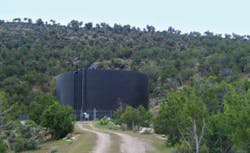The City of Rifle, Colo., knows painfully well that during summertime in the Colorado desert, the daytime heat loading on drinking water tanks can be intense. When exposed to long hours of sunlight, the water inside these tanks is heated and rises to the top of the tank, forming a layer of isolated, high-temperature water that can be up to 10°C (22°F) warmer than the fresh, cool water delivered during the tank’s daily fill cycles. This warmer layer floats up and down like a piston on top of the cooler bottom water and is never refreshed. Its elevated temperature promotes a rapid loss of disinfectant residual and accelerates biofilm and biological growth.
Unfortunately, most storage tanks were built before this phenomenon was fully understood. As a result, tanks are typically constructed with a common inlet/outlet pipe that is horizontally oriented, which means that the regular daily cycling of the tank often does not have adequate velocity or direction to disturb this upper layer. Until now, there was no effective way to stop this phenomenon.
The City of Rifle wanted to find out what would happen to water quality if it could prevent this isolated top layer of water from forming. If the fresh water coming into the tank could be vigorously mixed with the warmer water already stored in the tank, new disinfectant residual would come into contact with this older water to “burn away” any existing biofilm and stop biological growth.
The Solution
In order to break the stratification layers in the tank, the City of Rifle decided to install a 1/3-hp, solar-powered PAX mixing system that would create turnover in the tank on a continual basis. The mixer was specifically designed for mixing drinking water storage tanks and has a strong, vigorous mixing ability in both horizontal and vertical directions.
The mixer works by shooting a jet of cool water upwards from the bottom of the tank; this jet forms the center of a toroidal flow structure that moves the entire tank volume, leaving no dead spots. Computational fluid dynamics (CFD) and field data collected by temperature probes show that complete mixing is achieved over a period of just a few hours. A successful track record in steel and concrete storage tanks of similar volumes gave the City of Rifle confidence that a PAX mixer could solve its water quality problems.
The Results
Figure 3 shows the warming effect of solar loading in the 1-million-gal “airport” storage tank. During this one-month period (from mid-May to mid-June), the average water temperature in the reservoir increases from a cool 13°C (approximately 56°F) to a noticeably warm 19°C (approximately 66°F).
In June, the mixer was turned off for a ten-day period to achieve a baseline for the mixing comparison. During this time, the temperature of the water at the top of the tank increases and forms a separate layer from the water at the bottom of the tank (see Figure 3). This is exactly the phenomenon that Rifle had experienced in previous years—a separated upper layer formed and was no longer receiving residual during daily drain and fill cycles.
As the summer progressed, the average temperature in the reservoir continued to increase and eventually stabilized at approximately 24°C (approximately 75°F). Rates of reaction at 24°C are many times faster than at the springtime temperature of 13°C. This means that residual evaporates more rapidly and biological growth accelerates, thus leading to more disinfectant byproducts. In typical storage tanks without a mixer, this summer heat loading would lead to a heavily stratified tank where the upper layers increase well above the reservoir’s average temperature and the bottom layers remain isolated well below this average temperature. Figure 4, however, shows the effect of installing the mixer in the tank. Each day the temperatures begin to diverge due to the solar loading, and each day they are brought back together by the action of the mixer. The solar-powered mixer was configured to operate for eight hours per day, and during this daily operating period it was able to completely blend the water, thus delivering residual to all parts of the tank.
Stable and predictable water quality is vital to a well-run distribution system. Mixing water storage tanks keeps water protected and safe as it moves out into the distribution system and to customers’ taps. In the past, tanks have been a source of water quality degradation; now, with the introduction of the PAX active mixing solution, tanks can be kept more full and maintain better water quality.
Summertime temperature stratification was eliminated in the “airport” tank, and Rifle operations staff watched the summer pass by without a single water quality incident. The PAX mixing solution also improved water quality at another of Rifle’s tanks, and as a result it was able to protect its distribution system and network of pipes from seeing high-temperature, low-residual water, and maintain its ultimate goal to deliver better water to its customers.
“Our water quality was more consistent and our system was more stable and reliable after we installed the PAX mixer,” said Charlie Stevens, utility director at the City of Rifle. “This has been a great help to our operations and water quality staff.”



